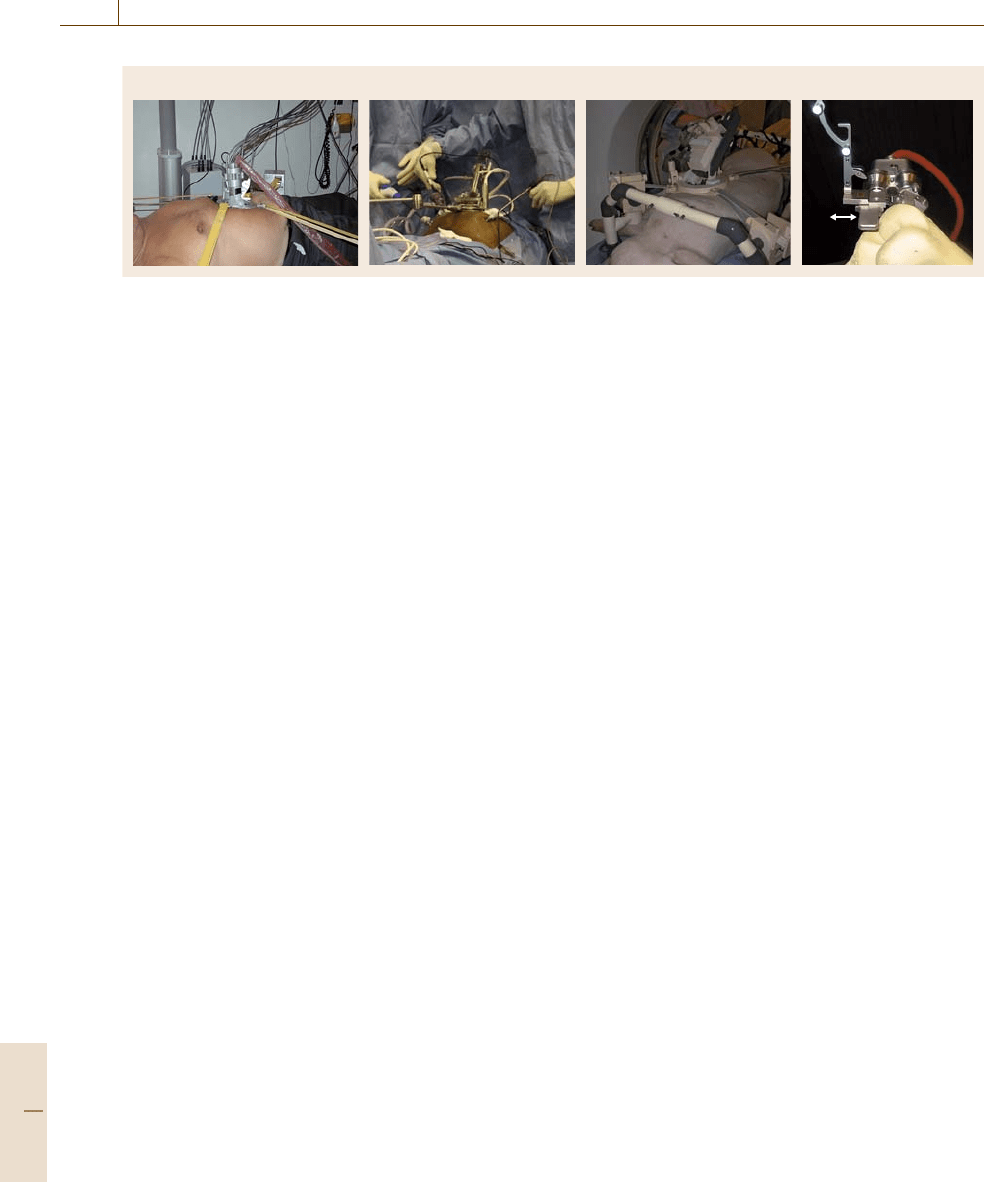Nof S.Y. Springer Handbook of Automation
Подождите немного. Документ загружается.


Computer and Robot-Assisted Medical Intervention 82.3 Main Periods of Medical Robot Development 1455
tion. This is why the idea of using a robot came very
naturally for such tasks. Robodoc [82.10, 11], used for
cavity preparation in total hip arthroplasty, was devel-
oped from 1986 first in a laboratory setup. Then, from
1989 to 1991, 29 dogs were operated with the help
of the system. The first ten patients were included in
a Food and Drug Administration (FDA)-approved clin-
ical research trial between 1991 and 1993; very large
series of patients for comparison of traditional interven-
tions with Robodoc-assisted ones were included from
1995 tothe early 2000s. Thousands of patients benefited
from the use of Robodoc. Robodoc is active in the sense
that a part of the surgical action (machining the bone) is
performed autonomously bythe robotunder surgeon su-
pervision. Several other systems were developed based
on a similar approach.
The underlying idea in this first period was that sur-
gical subtasks such as accurate positioning of a tool or
machining, based on numerical data, could be trans-
ferred to a robot and automated to a certain extent.
82.3.2 The Era of Interactive Devices
(1990–2005)
Whilst the automation era focused on rigid and non-
deformable anatomical structures, the second era is
characterized by the development of more interactive
control schemes for complex tasks, in particular for in-
terventions on soft tissues.
Indeed, in the two previous examples (Sect.82.3.1),
the anatomical structure of interest is rigid and nonde-
formable; in the case of stereotactic neurosurgery, the
brain is accessed through a small hole. The trajectory
through the hole is simple (a linear tool is inserted to
a given target). Brain motion and deformation can be
neglected and the skull is immobilized. As regards or-
thopaedics, bones are not deformable and can be fixed
to external fixturesto avoidanymotion. Obviously there
are much more clinical situations where the procedures
are more complex and concern soft, mobile, and de-
formable tissues. For such applications automation is
often still out of reach or may not be the preferred so-
lution, for instance, when the expertise of the clinician
is so complex that it cannot totally be transferred to the
robot.
In contrast to earlier automated robot control,
robotic development in the mid 1990s was charac-
terized by more direct operator control. In particular,
efforts were applied towards teleoperation; this form
of robotic application was traditionally used in the nu-
clear industry. In this situation, the surgeon is totally
in control of the surgical tool through a master–
slave apparatus. The distance between the master
and slave components is highly variable: although
the main use is for very close teleoperation (in the
same room), some very long distance (thousands of
kilometers) experiments havetaken place. Thefunction-
transferring movements from the master to the slave
may involve scaling down (forces and/or motions) and
filtering. The main clinical applications are in en-
doscopic surgery where instruments and optics are
introduced into the patient’s body through small inci-
sions. Those entry points limit the instruments’ possible
motions [four degrees of freedom (DOFs) instead
of six] and the surgeon has to operate under video
control. In a first stage, the motion of the optical
system – the endoscope – alone was robotized: in-
stead of requiring one assistant to move the endoscope
for hand–eye coordination, the robot is controlled by
the surgeon himself/herself by different means: voice
control (AESOP [82.12]), head movements (Endoas-
sist [82.13]) or high-level image processing software
(Sect.82.4). More recently the displacement of in-
struments has also transferred to robots, potentially
offering extra DOFs; this is the case of the DaVinci
multi-arm system that offers intrabody DOFsofthein-
struments [82.14].
From the mid 1990s synergistic devices [82.15] also
named hands-on robots [82.16] were proposed. The ra-
tionale for such systems is that the clinical application
is generally so complex that it can only be partially em-
bedded in numerical models and data. Therefore relying
both on the clinician for his/her very high skills, ca-
pacity of judgement, intelligent perception, and on the
computerized robot for its quantitative knowledge of
the planning, accuracy, and sensors is potentially very
fruitful. In the PADyC [82.17,18], Acrobot [82.16,19],
and Makoplasty [82.20] systems, the surgical tool is at-
tached tothe robot effector and the surgeon holdsit. The
motions proposed by the human operator are filtered by
the robot in order to keep only the part of the motions
which is compatible with the surgical plan; for instance,
the tool has to keep in a plane or in a given region.
Different technologies implement this principle of con-
strained motions: clutchable freewheels, backdrivable
motors, controlled brakes, etc.
82.3.3 The Era of Small and Light Dedicated
Devices (2000 to Present Day)
This era tends toward a miniaturization of robots up
to the stage where they can be attached to a body
Part H 82.3

1456 Part H Automation in Medical and Healthcare Systems
a) b) c) d)
Fig. 82.3a–d On-body and on-bone robots at Grenoble: (a) TER slave robot for tele-ultrasound examination (TIMC,
Grenoble University Hospital);
(b) LER-Viky endoscope holder (TIMC, EndoControl-Medical Company, Grenoble Uni-
versity Hospital and Paris La Pitié Salpétrière Hospital);
(c) LPR MRI-andCT-compatible robot for image-guided
punctures (TIMC, Grenoble University Hospital);
(d) Praxiteles robot for total knee arthroplasty (PRAXIM, TIMC,
Brest University Hospital)
part, inserted into the patient’s body or integrated into
mechatronic surgical instruments.
In systems presented in Sects. 82.3.1 and 82.3.2,
the robot mechanical architectures were inspired by
traditional industrial robotics: general-purpose anthro-
pomorphic six-DOF (or more) arms are used. Systems
are very versatile and can adapt to a variety of tasks.
However, this generality has a cost: these robots are
also very often quite cumbersome and are attached to
the floor, bed or ceiling. Their working space may be
quite large and not easily manageable in an operating
room (OR) that offers limited space and in which peo-
ple (patient and staff) are very close. This is why new
generations of robots have been specifically designed
and developed for limited application areas.
This new generation of systems has produced robots
so small that they can be supported by the patient body
or attached to one of his/her bones. Because of their
size these robots are more easily integrated into the
OR and are designed to be very well suited to a spe-
cific task. These two factors offer potential advantages
over traditional systems by providing a safer operat-
ing environment and cost effectiveness. The Grenoble
Techniques for Biomedical Engineering and Complex-
ity Management (TIMC) laboratory was a pioneer in
small-scale robotics, and Fig.82.3 illustrates four such
pioneering works. TER [82.21](Fig.82.3a), a robot
for tele-ultrasonic examination, has been clinically val-
idated for remote examination of abdominal aortic
aneurysm and for emergency care of abdominal trau-
mas; LER [82.22], a light endoscope holder, has been
validated on pigs and corpses, and VIKY, the corre-
sponding industrial product (Fig.82.3b) is European
Community (EC)-marked and has been used on pa-
tients; LPR [82.23](Fig.82.3c), a CT/MRI-compatible
robot for punctures, has been validated for CT on pigs
and for MRI on volunteers (but without puncture);
Praxiteles [82.24](Fig.82.3d), a robot for total knee
arthroplasty, has been validated on corpses and recently
entered multicentric clinical evaluation on patients.
Following the same philosophy, the Mars system
(now called Mazor [82.25], a product) is presented in
detail in Chap.78. It is being clinically evaluated on pa-
tients for spine surgery. This list of body-supported or
bone-mounted devices is not exhaustive.
Other systems are sufficiently small to be com-
pletely introduced into the body of the patient. Some
groups focus on locomotion issues; for instance, several
versionsof an inchworm-type compact robotthat moves
inside the intestine have been proposed [82.26]. The
aim is to replace the long, quite rigid, and painful en-
doscope traditionally used in colonoscopy; experiments
on pigs have been carried out successfully. With a rather
similar locomotion principle, a robot that moves on the
surface of the heart has been developed [82.27]; exper-
iments on live animals have been carried out. A robot
rolling on soft tissue organs in the abdomen has also
been described [82.28]; this robot carries a camera and
experiments on animal organs have been carried out.
Finally, a smaller and simpler device actuated from out-
side of the body using external magnetic fields has been
proposed [82.29]; such a robot would be injected into
the eye, for instance, for drug delivery to retina vessels.
Other research groups aim at giving extra DOFsto
traditional instruments: the domain of active catheters
that can adapt actively to vessel curvature has been in-
vestigated for several years [82.30,31]. Recently, some
of these systems have reached the market (Table 82.1).
Finally, the field of articulated tools for endoscopic
surgery is also very active; the aim is to developsurgical
Part H 82.3

Computer and Robot-Assisted Medical Intervention 82.3 Main Periods of Medical Robot Development 1457
Table 82.1 Industrial medical robots
System name Clinical specialty Type Last distributing Estimated number Status
company of installed systems
Neuromate Stereotactic Semiactive Schaerer Mayfield 15 < nb < 20 Unknown
neurosurgery (mechanical guide)
PathFinder Stereotactic Semiactive Prosurgics Ltd. Unknown Unknown
neurosurgery (mechanical guide)
Surgiscope Microsurgery Surgical ISIS 15 < nb < 20 No longer
microscope holder distributed
MKM Microsurgery Surgical Carl Zeiss Unknown No longer
microscope holder distributed
Robodoc Orthopaedics Automated ISS Inc. 70 < nb < 80 No longer
(knee, hip) machining of bones distributed
in the USA
and in
Europe
Caspar Orthopaedics Automated URS ortho 50 < nb < 60 No longer
(knee, hip) machining of bones distributed
Cyberknife Radiotherapy Positioning and Accuray Inc. 134* < nb Growing
motion of the
radiation device
DaVinci Endoscopic procedures Endoscope and Intuitive 875** < nb Growing
(cardiac, digestive, instrument holder Surgical Inc.
gynecologic, urology, etc.) – intrabody DOFs
Zeus Endoscopic procedures Endoscope and Intuitive Unknown No longer
instrument holder Surgical Inc. distributed
Aesop Endoscopic procedures Endoscope holder Intuitive 800 < nb < 1000 No longer
Surgical Inc. distributed
EndoAssist Endoscopic procedures Endoscope holder Prosurgics Ltd. Unknown Unknown
Naviot Endoscopic procedures Endoscope holder Hitachi Unknown Unknown
Lapman Endoscopic procedures Endoscope holder Medsys Unknown Unknown
Viky Endoscopic procedures On-body endoscope Endocontrol Probably < 10 Emerging
holder Medical
Acrobot Orthopaedics Hands-on robot Acrobot Ltd. Unknown Emerging
Sculptor (knee, spine, etc.)
PIGalileo Orthopaedics (knee) On-bone semiactive PLUS Orthopedics Unknown Unknown
CAS AG
Praxiteles Orthopaedics (knee) On-bone semiactive Praxim Probably < 10 Emerging
Makoplasty Orthopaedics (knee) Hands-on robot Mako Inc. Probably < 10 Emerging
Mazor Orthopaedics (spine, etc.) On-bone semiactive Mazor Surgical 10 < nb < 20 Emerging
Technologies
Estele Radiology Telerobotics Robosoft Probably < 10 Emerging
(ultrasounds)
Part H 82.3

1458 Part H Automation in Medical and Healthcare Systems
Table 82.1 (cont.)
System name Clinical specialty Type Last distributing Estimated number Status
company of installed systems
Sensei Interventional Teleoperated Hansen Medical Unknown Emerging
radiology (cardiology) robotic catheter for
heart mapping (intra-
cardiac) with force
feedback
CorPath Interventional Teleoperated Corindus On evaluation – Emerging
radiology (cardiology) catheter not yet distributed
(intracoronary)
* Number of installed systems in early May 2008 (source Accuray Inc.)
** Number of installed systems in early May 2008 (source Intuitive Surgical Inc.)
tools equipped with intrabody DOFs to recover full mo-
bility of thetools withrespect to the organs. The specific
area of intrabody devices raises very challenging issues
related to biocompatibility, safety, power supply, and
data transmission. Smart pills such as the M2A [82.32]
or Norika [82.33] ones, which are swallowed by a pa-
tient and enable visualization of the gastrointestinal
track, do not yet integrate active devices but can be seen
as precursors of future highly integrated mechatronic
intrabody devices.
82.4 Evolution of Control Schemes
Evolution from bone applications to soft tissues also
resulted in the evolution of control schemes providing
a more active role for the surgeon or aiming at a real-
time perception–decision–action control loop.
A large number of the oldest systems integrate
a single-shot perception–decision–action process; for
instance a planned trajectory is selected from CT data
and transferred to the intraoperative conditions after
registration of preoperative to intraoperative data. To
guarantee that the plan is still valid intraoperatively, the
anatomical structure of interest must not move. This
approach has been largely used for neurosurgery and or-
thopaedics surgery; in both cases the structure is fixed
using a stereotactic frame or external fixtures. The op-
erator is often limited to the role of a supervisor when
the robot moves the tool.
More recently (Sect. 82.3.2) the operator has been
given a more active role in the execution of the task.
In the case of comanipulation the robot and the oper-
ator participate simultaneously to the motions of the
tool. In the Acrobot system [82.19] the proportional–
integral–derivation (PID) coefficients of the control law
are given by functions that depend on the position of the
tool with respect to a region of allowed motions, which
corresponds for instance to the bone to be removed for
prosthesis implantation: inside the region, the motions
proposed by the operator and detected by a force sensor
are transmitted to the tool without significant modifica-
tion; in an intermediate region the motions are more or
less transmitted depending on their direction; motions
outside the planned region are strictly forbidden. The
Steady Hand [82.34] works similarly: the operator ma-
nipulates a handle and proposed motions are detected.
In contrast to the Acrobot, the Steady Hand does not
select permitted directions of motions but rather scales
down motions and forces for microsurgery or biology
applications. In the case of PADyC the principle is
slightly different [82.17, 18]; PADyC is a passive arm
for which each joint is equipped with two freewheels
than can be independently clutched or unclutched using
a motor; the motor is velocity controlled, and thisveloc-
ity determines the range of allowed motion of each joint
in each direction at each instant. This range of motion
is computed from the representation of the task (po-
sition to reach, trajectory to follow or region to keep
inside for instance) and from the current position of
the robot. No force sensor is necessary. For teleoper-
ation, the operator interacts with a master device and
the slave robot reproduces the motions proposed by the
operator. Transfer functions may enable scaling and fil-
Part H 82.4

Computer and Robot-Assisted Medical Intervention 82.5 The Cyberknife System: A Case Study 1459
tering of disturbingshaking motions likein theDaVinci.
Teleoperation canintegrate a force feedbackto the oper-
ator like in the Sensei system for endocardial robotized
catheter control.
Few systems integrate hybrid force–position control
of the robot. One application case is external ultrasound
examination, which requires constant contact of the ul-
trasonic probe on the body of the patient. Thus several
robotic systems for ultrasound examination (remote or
automated) have been developed with a hybrid control
scheme [82.35, 36]. They generally combine position
control in the main direction of motion with force con-
trol in order to maintain contact during probe motion.
Dermarob [82.37], developed for skin sampling for skin
grafts in burnt patients, follows a similar hybrid control
scheme.
Some of the systems developed for orthopaedics and
neurosurgery offer some basic tracking abilities using
a localizerand markers attachedto rigidstructures of in-
terest. This is, for instance, the case of Caspar, which is
used for ligamentoplastyin kneesurgery, and thecase of
a frameless version of the Neuromate. Systems such as
Mazor or Praxiteles which are mounted on the anatom-
ical structure of interest move with it and therefore
suppress the tracking problem. Recently other systems
have been developed with evolved abilities for tracking
of soft tissues. Instead of having a fixed target, the robot
has to track it in real time, in general from information
extracted from imaging data. Typical examples are re-
lated to organ motions induced by cardiac or respiratory
cycles. In those cases, a real-time perception–decision–
action loop must be developed. The Cyberknife system
(Sect.82.5) developed for radiotherapy [82.38, 39]de-
termines the current position of a tumor moving with
patient respiration by using external markers localized
in real time [82.40, 41]. Alternative approaches con-
sist of coupling motion in the image information to
motion of the robot at a low level through visual ser-
voing. Pioneer work was described in [82.42]; from
high-speed camera data, the motion of relevant fidu-
cials on the heart surface was computed and fed back to
a slave robot for teleoperation, giving the operator the
feeling of a stable target. More recently several groups
have appliedvisual servoing toimage-guided minimally
invasive actions. Video images are used for robotized
endoscopy [82.43,44]; ultrasonic images have also been
introduced [82.45,46] for cardiac and vascular applica-
tions. Directly coupling motion detection in the images
to motion of the joints requires very careful robustness
analysis.
82.5 The Cyberknife System: A Case Study
This system is described in more detail to make the in-
trinsic complexity of a robotic CAMI system a bit more
visible. This section isalso intendedto introducethe po-
tentially long road from an initial paradigm and a first
prototype to aclinically used product.Specific issues re-
lating to medical robotics and explaining this long road
are discussed in Sect.82.6.
The Cyberknife system,distributedby AccurayInc.,
has been developed in the context of radiotherapy. Usu-
ally, when treating a patient with conventional linear
accelerators, the patient is positioned onto a couch that
has four main DOFs (three translations and one rota-
tion), and the linear accelerator allows orientation of the
radiation beam using two more rotational DOFs. The
convergence point of the radiation beams is termed the
isocenter. A reference frame R
iso
centered on this point
is associated with the complete radiation system. The
DOFs enable positioning of the tumor on the isocen-
ter and orientation of the radiation beams properly with
respect to the tumor in order to execute the planned
treatment (Sect.82.2.1). In practice, due to the complex-
ity of positioning the patient and orienting the beams
with such machines, treatments generally consist of
rather simple ballistics with rather few radiation beams.
The Cyberknife concept proposes toinstall the radiation
source on a six-DOF robot in order to avoid repeated
combined motion of the couch and linear accelerator.
This enables the execution of complex treatments with
hundreds ofbeams distributed aroundthe tumorwithout
having to move the patient. Using such a large number
of small beams enables sculpting of the dose distribu-
tion to the tumor shape with high accuracy.
The first version of the Cyberknife [82.38]wasin-
stalled at Stanford Medical Center in February 1994,
and the first patient was treated with the system on
June 8, 1994. The current version of the system inte-
grates a Kuka robot (Fig.82.4a). In early May 2008,
the Accuray Company reported 134 installed systems
worldwide and 40 000 patients treated, mostly for brain,
spine, lung, prostate, liver or pancreas tumors.
Regarding patient data,preoperative CT is tradition-
ally used for treatment planning; other modalities can
Part H 82.5

1460 Part H Automation in Medical and Healthcare Systems
Calibration
Intra-treatmentPre-operative
Calibration
Initial registration
on markers
b)
a)
Internal markers External markers
Tracking
Model
R
x-ray(1)
R
loc
R
iso
R
robot
R
CT
R
x-ray(2)
Calibration
Diagnostic
x-ray source
Treatment
couch
Robot manual
control pendant
Image
detectors
Linear accelerator
Robotic arm
Fig. 82.4a,b The Cyberknife system: (a) the treatment room setup,
(b) functional description of tracking functionalities
be fused to CT data such as MRI or positron emission
tomography (PET) for planning refinement. Intraoper-
ative x-ray imaging produced by two x-ray systems
enables initial patient positioning and participates in
tracking. The system is calibrated, which means that
the spatial relationships between the different reference
frames R
iso
, R
robot
,andR
x-ray
(associated, respectively,
with the isocenter, robot, and x-ray devices) is deter-
mined using specific procedures and calibration objects.
Such calibration is necessary to transform intratreat-
ment imaging information into robot positions with
respect to the radiation system. The transfer of planning
information from R
CT
to R
iso
is possible due to image
registration procedures described in more detail in the
following sections.
In the first version of the system, dedicated to
neuro applications, after initial setup, patient motion
was detected and corrected before each dose deliv-
ery from a single beam. Thanks to the CT exam, two
synthetic x-ray images called digitally reconstructed ra-
diographs (DRRs) are computed. They correspond to
what would be seen by the two x-rays machines in
the treatment room for a perfect position/orientation
of the patient with respect to planning data. Two
real images are acquired just before dose delivery
and automatically compared with the DRRs; this re-
sults in the computation of the patient’s shift from the
ideal position/orientation. For small errors, the robot
position/orientation with respect to the patient is auto-
matically corrected by combining this information with
calibration data. For larger discrepancies, a replanning
phase is necessary to avoid any collision during robot
repositioning.
A later version of the system enables real-time
tracking of organs that move with patient respira-
tion (lung, liver, and kidney, for instance) [82.40]. As
regards patient respiration during treatment, several ap-
proaches are used in conventional radiotherapy: the less
accurate method consists of enlarging the targeted zone
to account for tumor motion; irradiating healthy tissues
is more acceptable than missing cancerous cells. This
enlarged zone can be computed by combining infor-
mation from two scanners acquired at the end of the
exhaleand inhale phases. A second approach consists of
synchronizing dose delivery to a given stage of the res-
piratory cycle (end of inhalation, for instance) but this
stage has to be reasonably repeatable and detected re-
liably. In a more sophisticated approach, such as that
developed in the Synchrony version of Cyberknife, the
system tracks the organ motion and the robot follows
this motion during dose delivery in order to execute
the planned treatment properly [82.41]. Since it is not
possible to obtain tracking information from x-ray im-
ages – as such organs may not be visible on radiographs
and continuous imaging would result in overirradia-
tion of the patient – a localizer is introduced into the
treatment room. This localizer, associated to R
loc
and
calibrated with respect to R
iso
, is used to track pas-
sive markers placed on the patient’s chest; it delivers
the marker positions about 20 times per second. X-ray
images can be acquired about every 10s. Because the
motion of internal organs is different from chest exter-
nal motion internal radiopaque markers are implanted
close to the tumor before the preoperative CT examina-
tion. The relationship between the tumor position and
the internal markers is determined using the CT data;
the internal markers enable initial patient setup by reg-
istration of CT data to x-ray images. The relationship
between internal markers visible on x-ray images and
Part H 82.5

Computer and Robot-Assisted Medical Intervention 82.6 Specific Issues in Medical Robotics 1461
external markers tracked by the localizer is learnt in
a preliminary stage where both data are acquired during
several breathing cycles. During dose delivery, between
two successive x-ray acquisitions, the position of in-
ternal markers is interpolated from the position of the
external markers and from the model; each new acqui-
sition enriches the model by adding a new couple of
synchronous positions of internal and external mark-
ers. Finally, the position of the tumor can be deduced
from the internal markers and fed back to the robot
for tracking and accurate dose delivery in spite of or-
gan motion. The different components of the tracking
function are illustrated inFig.82.4b. Current work deals
with noninvasive alternatives to the implanted internal
markers.
As can be seen in this example, a lot of hardware
and software components are associated with the robot
and many stages are involved in real-time determina-
tion of the robot position with respect to the patient. To
provide the required accuracy for precise dose delivery,
errors have to be reduced as far as possible for each of
these elements; this is especially demanding. Moreover,
because the robot developsvery large forces and torques
in the immediate vicinity of the patient, reliability and
robustness are mandatory. Unfortunately, as for many
other commercialized systems, due to intellectual prop-
erty issues few data are available concerning detailed
industrial developments and technical testing.
The Cyberknife approach supposes the ability to in-
stall a linear accelerator as end-effector of the robot;
the Cyberknife robot typically carries 6MeV accelera-
tors which are quite compact and light compared with
other radiation devices. When higher poweris necessary
or when radiation beams are produced by synchrotrons
and/or cyclotrons – for proton therapy, for instance –
the radiation source cannot be positioned and oriented
by a robot. Alternative systems [82.47] have been pro-
posed to position the patient robotically relative to the
radiation beam by means of parallel robotized seats or
robotized couches.
82.6 Specific Issues in Medical Robotics
As has been briefly introduced in the previous sections,
medical robotics raises specific issues at the technical,
clinical, and organizational levels in a very intricate
way. This section discusses those issues in more detail.
Firstly this type of robot has to be used in a human
environment. Because these robotic systems generally
require close collaboration with a clinician, specific
man–machine interface questions have to be resolved.
In the case of surgery, the operator cannot interact easily
with classical man–machine interfaces because he/she
has to work under sterile conditions. This motivates the
development of specific interfaces such as voice control
or foot pedals. In the case of comanipulation, the part of
the robot that is held by the clinician must be made ster-
ile before each intervention. Becausethe robot is used in
close proximity to human beings – at least the patient –
safety issues are mandatory. Safety has to be demon-
strated bothat thehardware and softwarelevels. Various
approaches are possible [82.48]. The choice of specific
architectures ofrobots or comanipulation control modes
may solve part of the problem. Norms and regulations
are intended to guarantee that the system is safe. How-
ever, it would certainly be interesting to develop such
systems usingspecific designmethodologies introduced
in critical applications (aeronautics, nuclear plants, etc.)
to really anticipate the behavior of such a complex sys-
tem and avoid any misuse. This direction is still to be
explored.
The clinical use of the robot also requires elec-
tromagnetic compatibility with the environment, in
particular in the OR. When the robot is used in spe-
cific environments such as inside a CT or MRI imaging
sensor, the robot must not disturb image acquisition or
corrupt the data. This may significantly constrain de-
sign choices and selected materials: for instance in the
MRI environment no ferromagnetic parts should be in-
tegrated into the robot. Sterile cleaning of the robot is
also an issue. Bone-mounted robots, which come into
very close contact to the patient, must be completely
cleanable. This is the case, for instance, for the Prax-
iteles and LER-VIKY systems (Sect.82.3.3), which are
autoclavable. In the case of larger robots, their end-
effector may be introduced inside sterile disposable
plastic bags. However, the robot connection with the
tool that is in contact with the patient has to be cleaned
in a sterile way. Finally, the system and the robot must
be designed such that the robotic procedure can be
easily and rapidly converted into the conventional in-
tervention, at any time, in case of problems. This may
also have important design consequences.
As mentioned previously, introducing a new med-
ical device requires demonstrating the added value
Part H 82.6

1462 Part H Automation in Medical and Healthcare Systems
over existing techniques from a clinical perspective;
for instance, using the robot could enable perform-
ing less-invasive interventions, resulting in shorter stay
of the patient in the hospital. In the same way, using
a robot to hold the endoscope may save one assistant
who can be transferred where his/her skills are used
in a much better way. However, evaluating such orga-
nizational benefits obviously requires very precise cost
and resource management: all necessary human or ma-
terial resources participating in the intervention, from
diagnosis to long-term follow-up, have to be taken into
account. On a more medical level, using a robot to
machine bone for prosthesis placement may result in
longer lifetime of the prosthesis and/or fewer joint dis-
junctions (for the hip, for instance). In a similar way
using a complex radiotherapy treatment delivered us-
ing a robot may allow dose escalation and may result
both in better control of a tumor and fewer complica-
tions. In general, it is not easy to predict how accurate
and sophisticated a roboticprocedure should be to make
a significant difference on the clinical level. To prove
this may also be very challenging. The evaluation of
clinical benefits may require long-term trials involv-
ing several centers and many patients. Those clinical
trials have to be conducted in accordance with the ethi-
cal standards and regulations of the country concerned;
those standards and regulations may be very strict, but
they vary from country to country. Finally, added value
may also beevaluated in termsof commercial advantage
for a hospital that may attract more patients when high
technology is used for painless, minimally invasive pro-
cedures. This added value should be significant enough
to compensate for drawbacks related to the introduction
of a robot such as the increase of procedure duration,
which is often observed even when the learning pe-
riod is finished. (See Chap. 77 for additional content on
automation in hospitals and healthcare.)
Cost is obviously another issue; indeed, several
of the distributed systems are quite expensive. If we
consider some of the systems (for instance, Robodoc,
Caspar, DaVinci, and Cyberknife) listed in Table 82.1,
costs average in the range US$1000000–2000000.
Aesop cost around US$100 000. Frequently a mainte-
nance cost of 10% per year has to be added, and some
of these systems generate an extra cost per intervention
(for instance, about US$1000–2000 for the DaVinci
system). This may be quite a heavy cost for hospitals
and clinics. Moreover, depending on healthcare funding
models in different countries, some of those costs may
not be affordable by health insurances. The higher the
investment, the more significant the added value has to
be to justify the expense. More recently developed sys-
tems (smaller and simpler robots, disposable devices)
are likely to propose more affordable solutions.
82.7 Systems Used in Clinical Practice
For 20years many medical robotic systems have been
developed in laboratories and evaluated to a certain
extent. Evaluation is twofold: at the technical level it
consists of characterizing accuracy, reliability, robust-
ness, etc. This stage may be realized on laboratory
setups using phantoms that mimic, more or less real-
istically, the concerned part of the body. At the clinical
level, experiments with corpses or animals enable a first
approach to a more realistic evaluation of clinical fea-
sibility and performance. Finally, a study on series of
patients is always necessary to fully evaluate the sys-
tem and its clinical added value. Relatively few medical
robots have undergone the whole evaluation process,
reached the market, and gone into wide clinical use.
There are indeed two major challenges: how to turn
a laboratory prototype into a certified product, and how
to make this product an industrial success. The rea-
sons for this still limited diffusion of medical robotics
in the clinical world certainly come from the spe-
cific constraints of medical robotics discussed above
and probably from the questionable added value of the
robot in a number of cases. The complexity of clini-
cal evaluation, certification, and marketing also makes
the process very long and expensive; for instance, in
orthopaedics, demonstrating the advantage of robots
over competing techniques may take more than 10 years
since the stability and life duration of prostheses cannot
be demonstrated any earlier. At the same time, to eval-
uate them it is necessary to install robots in hospitals,
sometimes atthe company’s expense. Convincinga hos-
pital to buy such expensive devices before any medical
evidence of their added value is available is particularly
challenging.
Table 82.1 attempts to list as largely as possible
the industrial systems that are, or have been, signifi-
cantly clinically used in routine and emerging products;
this table is intended to give a flavor of the clini-
cal spread of the technique. Numbers of systems are
estimates established in early 2008. As can be seen
several systems are no longer distributed: this de-
Part H 82.7

Computer and Robot-Assisted Medical Intervention 82.9 Medical Glossary 1463
serves further comments. Surgiscope and MKM, which
are both surgical microscope holders, probably faced
a limited added value versus cost ratio. As regards
Robodoc, this system had not yet demonstrated a clini-
cal benefit when misuse of the robot resulted in many
clinical complications and legal cases in Germany;
this ended up with the removal of the robot from
the US and European markets. Caspar, which offered
functions very similar to those of Robodoc, probably
suffered from the same unproven added value issue
and from the failure of Robodoc. Aesop and Zeus
are no longer distributed due to intellectual property
conflicts. Aesop was, however, very successful in clin-
ics and could certainly be considered as an industrial
success.
The success of DaVinci is probably due to its ability
to offer intrabody DOFs for endoscopic surgery; laparo-
scopic radical prostatectomy is one of the main clinical
vectors of the large dissemination of the DaVinci sys-
tem. As regards Cyberknife, the ability to perform
complex dose distributions with tens of small radiation
beams and the capacity to radiate the tumor accurately
during patient respiration are probably the keys to its
success. Moreover, conventional radiation apparatus are
expensive devices and cost issues may be less critical in
the case of radiation therapy than for surgery.
Table 82.1 also shows that emerging systems are
often based on quite different design philosophy:
small dedicated systems with more interactive control
schemes. As can be seen, favorite applications are in
endoscopy and knee arthroplasty, where the market is
large (6000000 laparoscopic surgeries per year world-
wide, and 600 000 knee prostheses per year worldwide).
Many other systems are somewhere in between the
academic and industrial worlds and are not included in
this table. Several of those forthcoming devices concern
the introduction of needles into the body (for biopsies,
punctures, brachytherapy, etc.).
82.8 Conclusions and Emerging Trends
In this chapter, we have introduced the main motiva-
tions for computer-assisted medical interventions and
presented the place of medical robots in this gen-
eral paradigm. Different generations of robots have
been proposed and evaluated worldwide, ranging from
systems inspired from industrial automation to more
specific clinical robots. In parallel to those evolutions
in terms of robot architecture and application areas, we
have shown that the control modes also evolved in dif-
ferent directions: giving a larger place to the operator
through real cooperation or closing the control loop
with real-time imaging data for tracking mobile and de-
formable targets. The future is probably in the merging
of such type of controls; for instance, the robot might
handle synchronization with a moving organ while the
operator would control the fine motions with respect to
the stabilized target.
As regards industrial products resulting from this
domain, the evolution has been very similar. The
future will tell if those new design choices will
result in a much larger spread of medical robots.
Reference [82.49] reports 39000 service robots for
professional use installed worldwide up to the end of
2006, among which 9% (about 3500 devices) would
be medical robots. However, this report does not tell
precisely what is included in this category (for ex-
ample, integration of haptic devices, integration of
mechanical localizers or others). From the numbers
mentioned in Table 82.1, our estimate of installed robots
in 2008 would be closer to 2500, which is proba-
bly less than half the number of installed navigation
workstations. Increasing this ratio requires careful se-
lection of applications with significant added value
and the development of user-friendly cost-effective
systems. Intrabody highly integrated mechatronic de-
vices potentially open the range of applications in
a dramatic way. This domain has still to be largely
explored.
82.9 Medical Glossary
•
Aneurysm: a local hernia on a blood vessel po-
tentially resulting in vessel rupture and internal
haemorrhage
•
Autoclavable: being cleanable in the autoclave
(pressured vapor sterilization with temperatures
greater than 100
◦
C)
Part H 82.9

1464 Part H Automation in Medical and Healthcare Systems
•
Arthroplasty: plastic surgery of the joints involved,
for instance, in joint replacement (e.g., hip, knee)
•
Biopsy: the action of taking samples of a tissue with
a needle for further analysis
•
Brachytherapy:the introduction of radioactive seeds
into an organ for tumor destruction
•
Catheter: a flexible tube introduced into the body,
typically blood vessels, for instance, to inject drugs
or to place dilatation devices. Generally, the end of
the catheter can be slightly curved by the physician
from the outside of the body
•
Colonoscopy: endoscopic examination of the colon
•
Computed tomography (CT): 3-D imaging from
x-ray acquisition, enabling good visualization of
bony structures and air cavities
•
Digitally reconstructed radiograph (DRR): a syn-
thetic x-ray projection image computed from a CT
volume being given the position of a virtual source
and virtual image plane
•
Endoscopic surgery: surgery involving a minimal
access to the body through natural cavities or inci-
sions and visualization of the internal organs using
rigid or flexible optical sensors (the endoscope)
•
EC marking: the certification from the European
Community necessary for marketing a products of
any type in the Economic European Community; it
insures that the product complies with the European
regulations in terms of safety, health, environment,
etc.
•
FDA: Food and Drug Administration; the US ad-
ministration in charge of controlling the safety and
efficacy of health-related products
(http://www.fda.gov)
•
Interventional radiology: a category of therapeutic
or diagnostic procedures executed under imaging
control
•
Magnetic resonance imaging (MRI): 3-D imaging
from magnetic resonance of hydrogen protons in
the body, enabling detailed visualization of soft tis-
sues
•
Neurosurgery: brain or spine surgery
•
Operating room (OR): also called operating theater
•
Orthopaedics: a surgical specialty dealing with
skeleton bones and joints
•
Positron emission tomography (PET): a functional
imaging modality in which a radioactive marker is
associated to a metabolically active molecule and
injected into the body of the patient; the metabolic
activity is traceable thanks to the radioactive marker
and can be reconstructed in 3-D thanks to to-
mography techniques similar to the one used for
CT
•
Puncture: the action of inserting a linear tool (a nee-
dle or an electrode for instance) into the body
•
Preoperative, intraoperative, postoperative: before,
during, after the intervention
•
Prostatectomy: surgical removal of the prostate in
case of cancer; laparoscopic prostatectomy is the
minimally invasive version of this surgery
•
Radiopaque: visible on x-ray images
•
Radiotherapy: the destruction of pathologic tissues
(mostly tumors) by ionizing particles
•
Stereotactic neurosurgery: a minimally invasive ac-
cess to the brain requiring very accurate localization
of intracranial structures
•
Stereotactic frame: a mechanical device for perfect
immobilization of a patient’s skull, also used for
transferring the surgical plan and for guiding the
surgical tool
•
Ultrasonic examination: an imaging modality (2-D
or 3-D) based on the propagation of ultrasound in
the body; it visualizes tissue interfaces.
References
82.1 P. Cinquin, E. Bainville, C. Barbe, E. Bit-
tar, V. Bouchard, L. Bricault, G. Champleboux,
M. Chenin, L. Chevalier, Y. Delnondedieu, L. Des-
bat,V.Dessenne,A.Hamadeh,D.Henry,N.Laieb,
S. Lavallée, J.M. Lefebvre, F. Leitner, Y. Men-
guy, F. Padieu, O. Peria, A. Poyet, M. Promayon,
S. Rouault, P. Sautot, J. Troccaz, P. Vassal: Computer
assisted medical interventions at TIMC laboratory:
passive and semi-active aids, IEEE Eng. Med. Biol.
Mag., special issue Robot. Surg. 14(3), 254–263
(1995)
82.2 D.L.G. Hill, P.G. Batchelor, M. Holden, D.J. Hawkes:
Medical image registration, Phys. Med. Biol. 46,
R1–R45 (2001)
82.3 M. Chabanas, V. Luboz, Y. Payan: Patient
specific finite element model of the face
soft tissues for computer-assisted maxillofa-
cial surgery, Med. Image Anal. 7(2), 131–151
(2003)
82.4 E. Watanabe, T. Watanabe, S. Manaka, Y. Mayanagi,
K. Takakura: Three-dimensional digitizer (neuro-
navigator): A new equipment for CT guided
Part H 82
